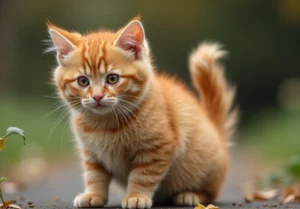Have you ever wondered why house cats are so small? The answer lies in their evolutionary history and unique characteristics.
Evolution of House Cats
House cats, with their charming small size, have evolved over thousands of years through the process of domestication. When humans first started domesticating wild cats, they favored smaller individuals because they were easier to manage and posed less of a threat. This preference for smaller cats over time has influenced the genetic makeup of house cats, leading to their diminutive stature compared to their wild feline relatives.
The small size of house cats also provides advantages in a human environment. Their compact bodies make them well-suited for living indoors, navigating tight spaces, and fitting comfortably into our homes. Smaller cats are often more agile and dexterous, allowing them to climb and explore their surroundings with ease. Additionally, their diminutive size makes them less intimidating to humans, fostering a closer bond between cats and their human companions.
Physical Adaptations
House cats possess a variety of physical adaptations that contribute to their small size and overall agility. One key adaptation is their flexible bodies, which allow them to squeeze through narrow openings and move with grace and precision. Cats’ keen senses, including sharp eyesight and acute hearing, also play a role in their compact size. These heightened senses help cats navigate their environment effectively, compensating for their small stature.
Furthermore, cats’ lightweight skeletons and muscular bodies enable them to move swiftly and with great agility. Their retractable claws provide traction and improve their ability to climb and catch prey. Overall, these physical adaptations have been finely tuned through evolution to create the perfect feline companion for indoor living.
Additional Insight: Unlike their larger wild counterparts, house cats do not require as much space to roam and hunt for food. Their small size allows them to thrive in a smaller living environment, making them ideal companions for apartment-dwellers and urban residents.
Behavioral Traits
House cats are small for many reasons, with their size playing a significant role in their behavioral traits. Due to their compact bodies, they have agility, quick reflexes, and a keen sense of balance, which are essential for their hunting techniques. Small size allows them to move swiftly and silently, making them efficient hunters of small prey like birds and rodents. Additionally, their size influences their social interactions, as smaller cats tend to be more cautious and less confrontational in their dealings with other animals.
Comparison to Wild Cats
When comparing house cats to their larger wild counterparts like lions and tigers, the differences in size can be attributed to the environments they inhabit and their evolutionary history. Wild cats have evolved to survive in harsher conditions and compete for larger prey, requiring them to be larger and more powerful. On the other hand, house cats, through domestication, have adapted to living in close proximity to humans and have a different set of survival challenges, leading to their smaller size.
Additional Insight: Size and Domestication
One unique insight into the size difference between house cats and wild cats is the impact of domestication on their physical characteristics. Domestic cats have undergone selective breeding for traits that are desirable to humans, such as smaller size, different coat colors, and specific behavior patterns. This intentional breeding over generations has contributed to the overall smaller size of house cats compared to their wild counterparts.
Environmental Factors
House cats are small primarily due to environmental factors that have influenced their size over time. In their natural habitats, cats needed to be agile and stealthy to hunt for prey, leading to a smaller body size compared to larger predators. Additionally, limited food availability in the wild meant that smaller cats had a better chance of finding enough food to survive.
Unique Insight: Cats’ size was also influenced by the type of prey available in their environment. Cats living in areas with smaller prey tended to be smaller themselves, as they didn’t need to grow as large to catch their meals.
Health Implications
The small size of house cats can have various health implications, including genetic predispositions and breed-specific issues. Certain breeds are more prone to health problems due to their small stature, such as respiratory issues in flat-faced breeds like Persians. Genetic factors also play a role in determining a cat’s size, leading to potential health concerns related to bone structure and organ function.
Overall, the size of house cats is a complex interplay of environmental factors and genetic predispositions that have shaped these feline companions over time. Understanding these factors can help cat owners provide the best care for their beloved pets.
Fun Facts
Small cats, including house cats, are tiny powerhouses of agility and stealth. While they may seem diminutive compared to their larger counterparts, their compact size is actually an evolutionary advantage that helps them excel in hunting and navigating tight spaces. Did you know that small cats have incredibly flexible bodies, allowing them to squeeze through narrow openings with ease? This unique ability comes from their well-developed collarbones, which are not fixed like those of larger cats, giving them exceptional flexibility to wiggle through small gaps.
Future Perspectives
As research on feline genetics and evolution progresses, scientists are gaining a deeper understanding of why house cats are so small compared to their wild relatives. One fascinating area of study is investigating the genetic factors that influence cat size, with the potential for future developments in selectively breeding cats for specific sizes. By unlocking the genetic secrets behind feline size, researchers may one day be able to manipulate cat sizes more precisely, leading to the emergence of new breeds that vary in size and appearance. This could open up a whole new world of possibilities for cat enthusiasts looking for the perfect feline companion.
Alex, a passionate animal lover, has experience in training and understanding animal behavior. As a proud pet parent to two dogs and three cats, he founded AnimalReport.net to share insights from animal experts and expand his knowledge of the animal kingdom.




